“Lady with an Ermine” by Leonardo da Vinci – Discover the Artwork
Leonardo da Vinci was working as a painter in Milan’s Sforza court at the time that this painting of a lady holding a ferret was produced. Lady with an Ermine by Leonardo da Vinci is one of only four portraits featuring women still surviving to the present day. This famous painting of a lady holding a ferret was produced in oils on a walnut panel. To learn more about this artwork, join us below as we provide a Lady with an Ermine analysis and other interesting facts about the piece!
Contents
Exploring Lady with an Ermine by Leonardo da Vinci
| Artist Name | Leonardo da Vinci (1452 – 1519) |
| Date Completed | 1489 – 1491 |
| Medium | Oil on walnut panel |
| Dimensions (cm) | 54 x 39 |
| Location | Czartoryski Museum, Kraków, Poland |
The subject of this painting is believed to be Ludovico Sforza’s mistress, Cecelia Gallerani. She had grown up in a large family who were not particularly renowned or noble, yet her father had worked in the Duke’s court for a while. Gallerani would have been around 16 years old at the time this painting was produced and was known for her poetry and exceptional beauty.
She was previously married to a young nobleman when she was only six years of age but was later able to divorce him.
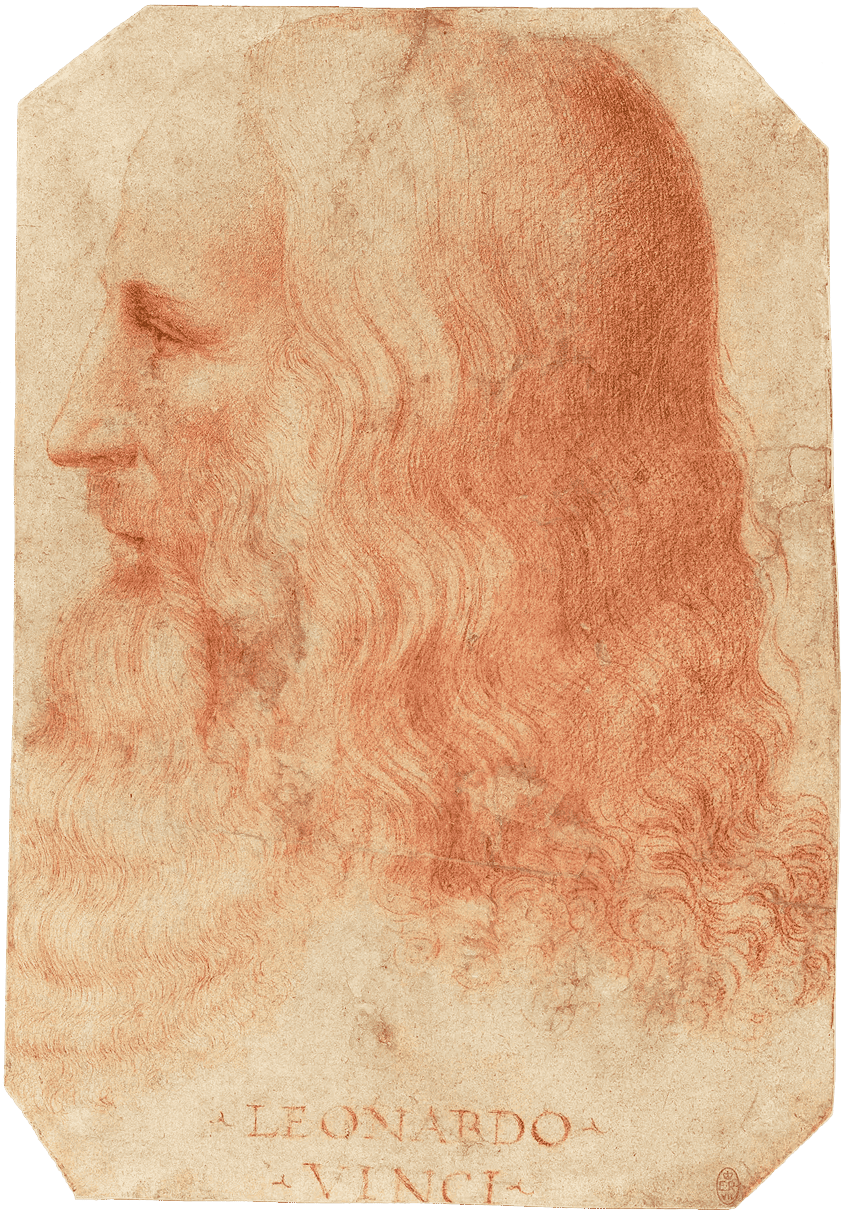
At this point, she became the Duke’s mistress and together they had a young boy. However, the Duke was already married, and upon hearing of their relationship, forced Gallerani to get married to another man by the name of Count Ludovico Carminati di Brambilla.
The History of Lady with an Ermine by Leonardo da Vinci
Da Vinci left his homeland of Florence for the opportunity of a lifetime in 1482. He was offered employment in the court of Milan and there, he created one of his most exceptional portraits, a painting of Cecilia Gallerani, Ludovico’s favorite mistress. While Da Vinci is believed to have wanted to pursue a career as a military engineer in Milan, none of the several military devices he designed for Ludovico Il Moro appear to have been realized. It was however, during this period, that he produced one of his most well-known portraits.
While it had always been known to scholars that Da Vinci had produced a portrait of Cecelia Gallerani, the actual artwork remained unknown until the late 19th century. It is believed that Cecilia took the painting with her when she eventually left Ludovico.
The painting was passed down through her heirs until it ended up in the possession of an aristocratic Polish family that traveled extensively in Italy throughout the 1700s. Prince Adam George Czartoryski bought the painting in 1798 in Italy and it was incorporated into his family’s collection two years later. Even though the work had never been discussed in print, the prince was sure it was a Da Vinci and had the artist’s name inscribed in the corner of the work next to the name Belle Ferronière, which is also the title of another of Da Vinci’s portraits.
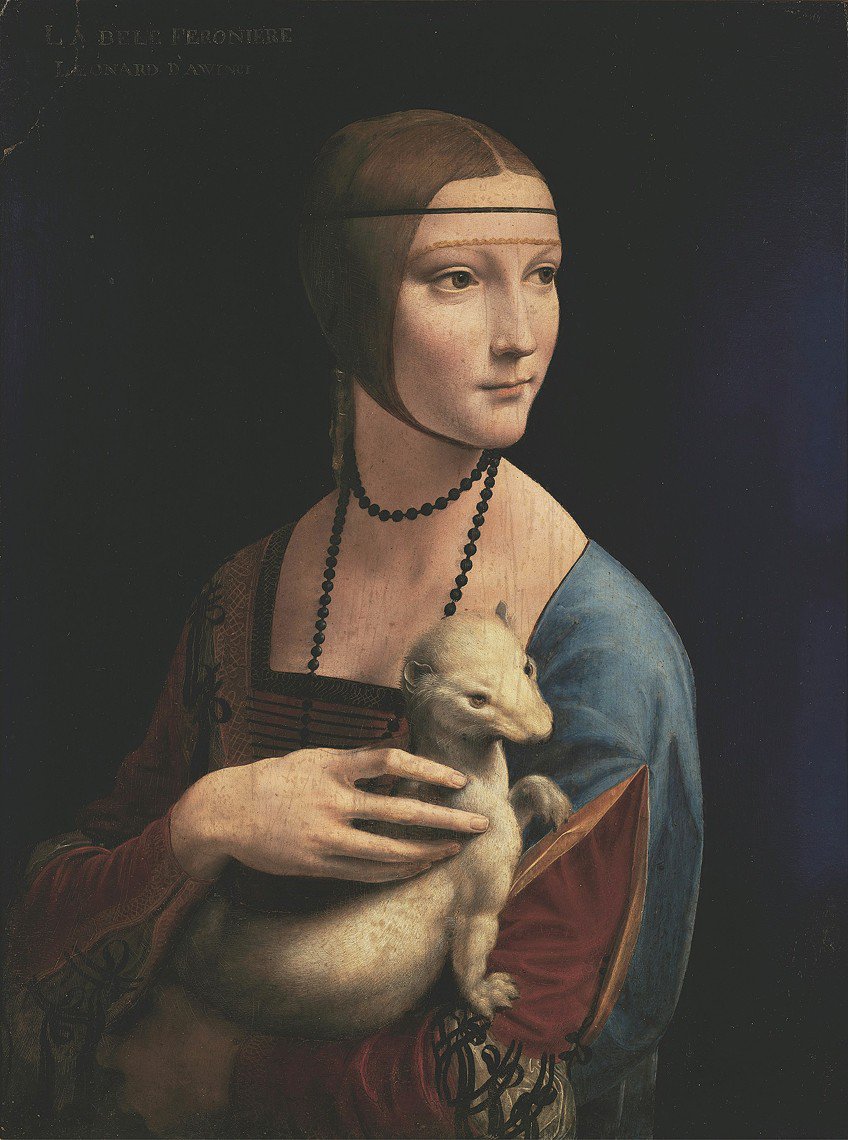
Czartoryski felt that the women in both portraits bore such a resemblance that they were, in fact, the same person. During the 19th century, the artwork traveled extensively. Princess Czartoryska, who was 84 years old at the time, rescued the artwork in the November Uprising of 1830 from the Russian army, hiding in Sieniawa, around 150 kilometers away from the approaching invaders. It was then moved to the Hôtel Lambert in Paris shortly after that. In 1871, after the German occupation of Paris, the artwork once again returned to Poland.
During World War I, it was temporarily moved to Dresden before again returning to Poland. The artwork was once again transported to Sieniawa in 1939 when it was found and subsequently seized by the Nazis, who then had it transported to Berlin’s Kaiser Friedrich Museum.
Poland’s Governor General, Hans Franks, saw the artwork there in 1940, after which he requested that it be returned to Poland. This request was granted and the artwork ended up hanging in his office. It was discovered by the Allied troops at the close of World War II and was placed in the Czartoryski Museum where it has been exhibited ever since. The artwork traveled more than any other Da Vinci painting during the second half of the 20th century.
Lady with an Ermine Analysis
This artwork portrays a woman sitting at a three-quarter angle, with her body facing her right and her head facing her left. The ermine is similarly twisted in its pose, creating a significant contrapposto with the woman, something Da Vinci had mastered in several of his earlier works. The portrait is naturalistic in a period when realism painting techniques were still being developed, with Cecilia’s entire pose having an organic and spontaneous feel.
Similar to works such as the Mona Lisa, Da Vinci mostly applied the paint evenly, although there is slightly more layering on the woman’s face.
Da Vinci was believed to have favored walnut panels and it is thought this work was painted onto a panel that came from the same tree as the panel used for La Belle Ferronnière. Both artworks also feature very dark backgrounds. A technical analysis of the painting that took place in 1996 revealed that the background had been a grayish blue color originally but had been over-painted with black sometime in the mid-18th century. Cecilia’s outfit underneath the ermine was also fixed, and the translucent veil had been recolored to match the color of her hair.
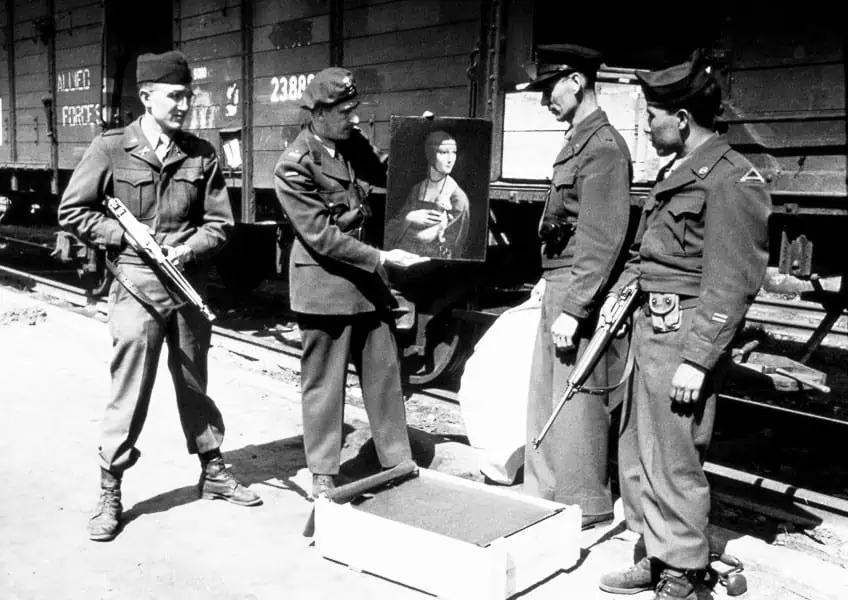
This last modification created the illusion that her hair extends down and beneath her chin. The presence of a door in the background can also be seen in an x-ray of the painting. Analysis of the painting has revealed another secret. In 2014, French scientists found that Da Vinci painted the painting in three separate phases rather than simply one. His initial version was a straightforward portrait without any animal. He then incorporated a little gray ermine on the second version. The animal was turned into a larger white ermine in the final version.
In general, the artwork is regarded to be in very good condition, considering its long history of being hidden and transported to various locations through the years.
The Woman in the Painting
The light falls across the artwork from upper right to bottom left, gradually lighting the sitter with balanced clarity. The subject’s alert gaze offers the impression of immediacy. It seems like her attention has been drawn to something outside the frame. It has been suggested that the woman in the painting is staring in the direction of her lover, Ludovico Sforza. We can see a silk sbernia draped across her left shoulder.
This would traditionally have been worn over both shoulders, however, Da Vinci opted to only place it over one shoulder for the sake of simplifying the overall arrangement and to avoid detracting from the ermine’s head.
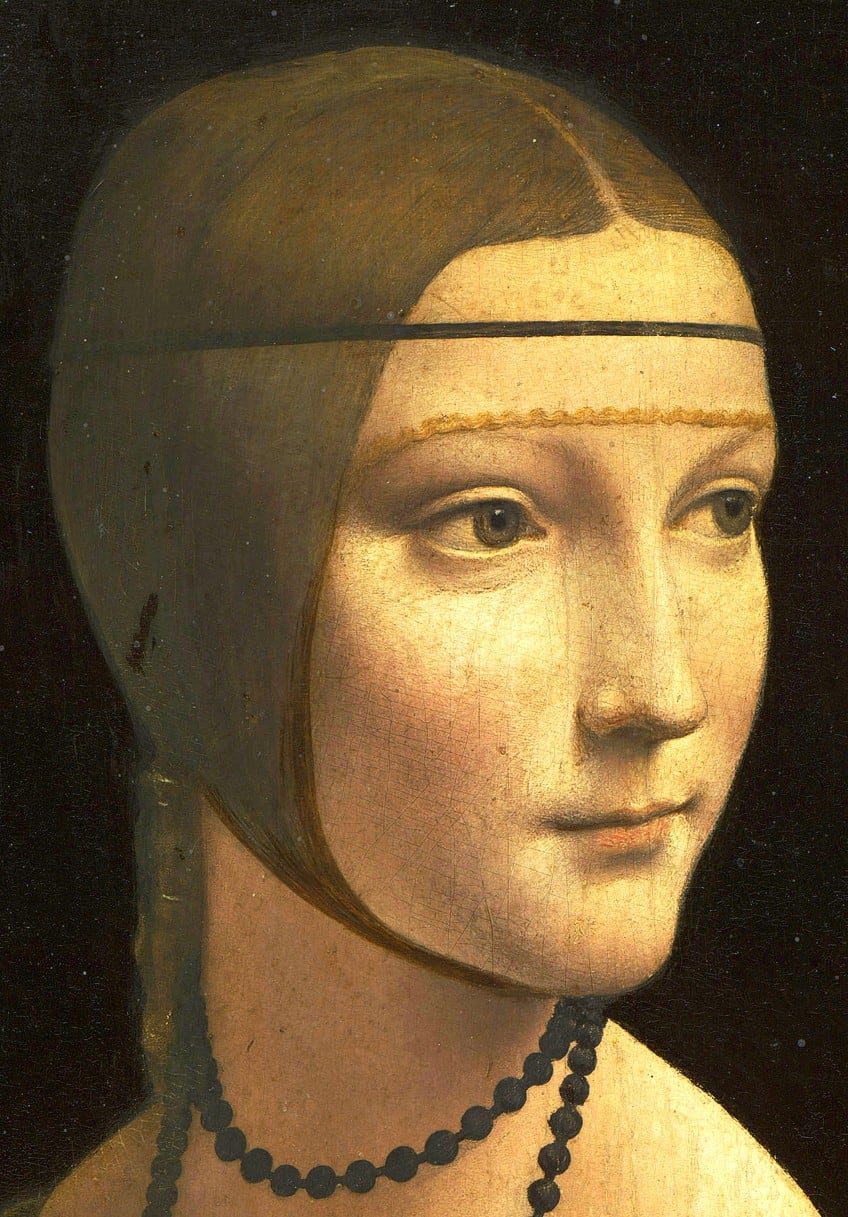
The composition of this painting consists of a pyramidic spiral, like in many of Da Vinci’s works, and its subject is caught in the action of moving to the left, illustrating the artist’s lifelong interest in the dynamics of movement. This work of art in particular demonstrates Da Vinci’s skill in depicting the human figure, with much emphasis put on portraying the little details of the hand.
The Ermine
The animal featured in the painting is often referred to as a stoat or ermine. However, it has been pointed out that the animal portrayed is far larger than an actual ermine, leading to the conclusion that its size is symbolic in nature. In fact, many regard it to be a hybrid creature featuring aspects of several animals that the artist was drawing at the time. People have put forward several various theories as to what the animal portrayed symbolizes.
The ermine was a traditional emblem of restraint and purity in its winter coat since it was reputed that it would rather die than stain its white coat.
In his older years, Da Vinci himself noted in his bestiary that the animal was known to only eat once a day and would rather take the risk of being captured than hide in a dirty lair. The ermine was also said to have particular meaning for Ludovico Sforza, who was a member of the Order of the Ermine and used it as his personal insignia. It has also been suggested that Da Vinci incorporated the animal as a visual pun since Cecelia Gallerani’s surname sounded similar to galéē, which is the ancient Greek word for an ermine.
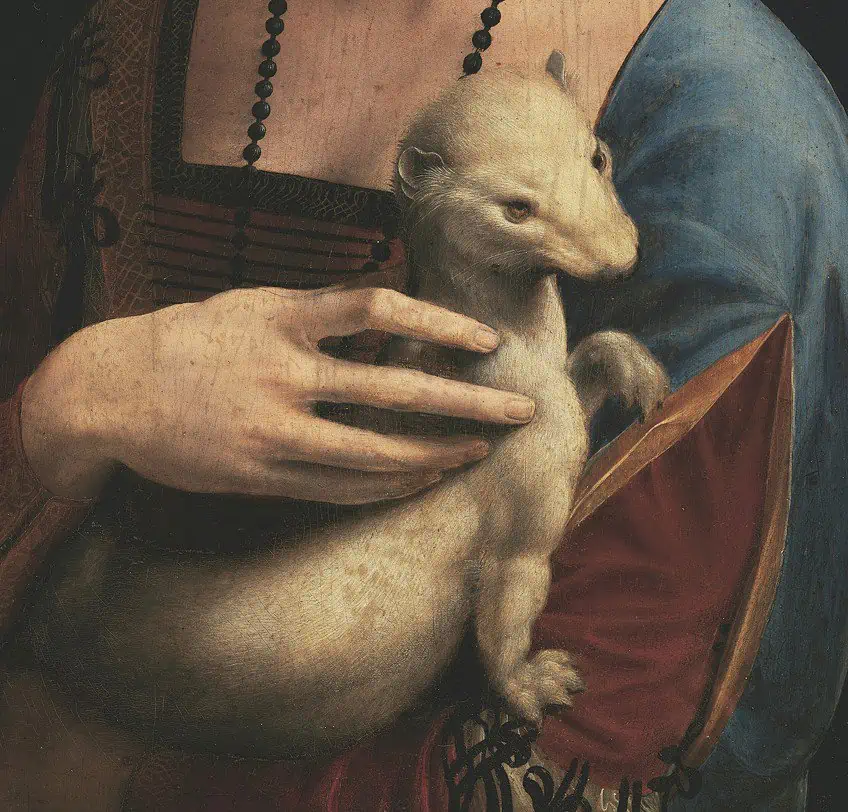
These types of visual puns were particularly fashionable in the Renaissance era and Da Vinci himself used them in other works, such as his portrait of Ginevra de’ Benci, which featured juniper trees in the background. A juniper tree is known as ginepro, which sounded similar to the sitter’s first name. Another theory is that the animal symbolizes the protection of pregnant women, as ermines were known to symbolize pregnancy in classical literature and the sitter was pregnant with the count’s illegitimate child at the time this painting was produced.
Despite being hauled from one country to the next over the span of many war-filled years, it is quite an exceptional feat that this painting of a lady holding a ferret still exists! In fact, it is still considered to be in remarkably good condition given these circumstances. While this artwork exemplifies Da Vinci’s ability to depict human anatomy with great realism, it also incorporates the ermine as a symbol relating to the patron as well as to the sitter. For the patron, it had significance as he was a member of the Order of the Ermine. As for the sitter, the ancient Greek word for ermine sounded similar to her surname, resulting in a visual pun. What is particularly remarkable about this painting is that it is one of only four portraits of women that Da Vinci produced known to still exist.
Frequently Asked Questions
Why Did Da Vinci Paint a Lady Holding a Ferret?
The animal portrayed is believed to be some sort of stoat or ermine. However, it has been pointed out that the animal is actually much larger than a typical ermine. For this reason, many people believe that the animal simply serves a symbolic function, as it represents purity.
What Is Lady with an Ermine by Leonardo da Vinci About?
This painting by Da Vinci features a portrait of a woman with an ermine resting in her arms. She was believed to be the mistress of Da Vinci’s patron, Ludovico Sforza. The ermine was said to have symbolic connections to both Sforza and the sitter herself. He was a member of the Order of Ermine, and her surname was similar to the ancient Greek word for the animal. It was also believed to represent purity because the ermine never soiled its magnificent coat.
Jordan Anthony is a Cape Town-based film photographer, curator, and arts writer. She holds a Bachelor of Art in Fine Arts from the University of the Witwatersrand, Johannesburg, where she explored themes like healing, identity, dreams, and intuitive creation in her Contemporary art practice. Jordan has collaborated with various local art institutions, including the KZNSA Gallery in Durban, the Turbine Art Fair, and the Wits Art Museum. Her photography focuses on abstract color manipulations, portraiture, candid shots, and urban landscapes. She’s intrigued by philosophy, memory, and esotericism, drawing inspiration from Surrealism, Fluxus, and ancient civilizations, as well as childhood influences and found objects. Jordan is working for artfilemagazine since 2022 and writes blog posts about art history and photography.
Learn more about Jordan Anthony and about us.
Cite this Article
Jordan, Anthony, ““Lady with an Ermine” by Leonardo da Vinci – Discover the Artwork.” artfilemagazine – Your Online Art Source. November 1, 2023. URL: https://artfilemagazine.com/lady-with-an-ermine-by-leonardo-da-vinci/
Anthony, J. (2023, 1 November). “Lady with an Ermine” by Leonardo da Vinci – Discover the Artwork. artfilemagazine – Your Online Art Source. https://artfilemagazine.com/lady-with-an-ermine-by-leonardo-da-vinci/
Anthony, Jordan. ““Lady with an Ermine” by Leonardo da Vinci – Discover the Artwork.” artfilemagazine – Your Online Art Source, November 1, 2023. https://artfilemagazine.com/lady-with-an-ermine-by-leonardo-da-vinci/.



